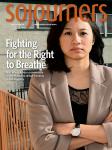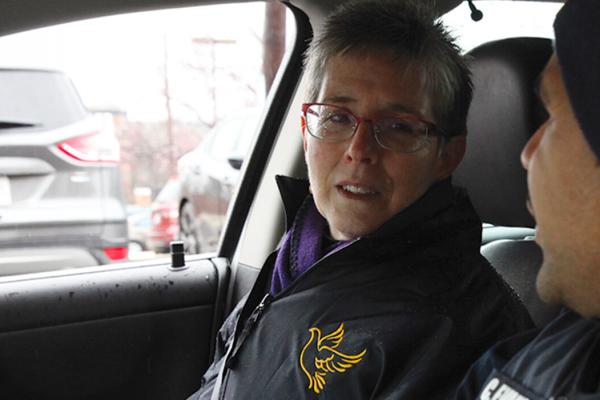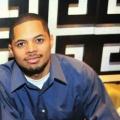EARLY LAST YEAR a Hyattsville, Md. man arrived home to find police cars and crime scene tape on his walkway. He learned that his younger sister had accidentally overdosed, and the coroner had been summoned to rule out foul play. The man wanted to enter the house, view his sister’s body, and perhaps say his goodbyes. But the police wouldn’t allow him inside.
“I could see when he started walking up the walk that he was unhappy,” said Rev. Stephen Price, who police called to the scene. “He and the officer were having a very tense conversation,” said Price, pastor of First Baptist Church of Hyattsville.
So Price intervened. “He’s mad and the officer is feeling strained,” Price later explained. “I said, ‘Walk with me a minute.’” The man vented his frustration, but eventually calmed. Price explained what the police needed to do and persuaded the man to stand with his family while police finished their work in the home. In the interim, Price promised to be a go-between for the man and the officers until the body was released. Shortly after, the family was allowed inside. They invited Price to join them, and he led them in prayer.
For the family, it was a day of tragedy and grief. For police, it was a daily reality of their job: dealing with death and navigating mistrust from the community they serve. Yet, for a nation where interactions with law enforcement all too often end with violence, it was a small step in the right direction: The police responded to a call, tensions were diffused, and no one got hurt.
Serious trust issues
To understand why Hyattsville officers called a pastor to the scene, rewind to December 2014, when President Obama signed an executive order to create the Task Force on 21st Century Policing. Citing the protests that had erupted over law enforcement’s role in the deaths of unarmed black men, the task force aimed to find ways to restore trust between communities and law enforcement. Eventually, the task force released guidelines that included more transparency and accountability in police actions, increased community partnerships, and updated officer training on the use of force.
A number of cities made efforts to implement these guidelines, including Philadelphia, which created a 24-member Police Community Oversight Board, and Madison, Wisc., where police officers are now required to use body cameras.
Hyattsville is a mixed-race city in Prince George’s County, just outside of Washington, D.C. Like many cities, tension between police and the community is palpable: In March 2016, a black plainclothes detective, Jacai Colson, was shot by a fellow officer who mistook Colson for a civilian. This February, an off-duty officer was killed by a civilian when the officer stepped in to aid a neighbor who was being threatened by her estranged husband.
Incidents like these are why the Hyattsville Police Department called Price to the scene that January day. Since June 2016, the department has partnered with local clergy. “The city held a breakfast at which they invited us to explore ways that the city might partner with the town’s faith community,” said Price of their first meeting in 2016. Elected officials, city staff, and police department representatives also attended, some of whom had participated in discussions at the White House on the Task Force on 21st Century Policing. Shortly after the 2016 gathering, Price and a handful of other pastors agreed to partner with the police; today there are six pastors involved in what they call “the Hyattsville community chaplains/police group.”
As a part of those efforts, pastors volunteer to respond to death notices with officers and to participate in occasional “ride-alongs,” joining police from the passenger seat as officers patrol their beat and answer calls. The clergy members have shirts and jackets that identify them as community chaplains.
For chief of police Douglas Holland, the presence of a pastor is a welcome addition because officers often have a technical job to do that may take priority over other matters. “Sometimes it may look like the officers are just being hard or callous or not paying a lot of attention to the emotional needs of some of the victims or some of the families,” said Holland. “The pastors are there and are able to help with that.”
But another aspect of this partnership is a monthly discussion group between the participating clergy, the police chief, and other officers. These meetings take place at the police department, in Holland’s office, and those in attendance discuss current national and local events. A recent meeting addressed how police in Hyattsville would respond to a school shooting and what churches could do to prevent such tragedies. Previously, the group strategized how to work together to help Hyattsville’s homeless population. Captain Amal Awad, the department’s deputy chief, noted that homeless individuals “are sometimes hesitant or apprehensive” to speak with police, but may be more open to a conversation with a pastor.
“However, we are working on removing those barriers to communication; our focus is earning and building trust,” said Awad. Clergy can help bridge that gap: Officers can suggest shelter, explained Awad, but clergy may be able to offer a warm meal or warm bed or even call in a nonprofit to help.
Taking a risk
When Rev. Nathan Hill, pastor of University Christian Church in Hyattsville, heard about the group, he was eager to join.
“I think it was coming out of Ferguson, out of Baltimore, some of the unrest, the riots, the anger, the division, the disconnect, the injustice of those situations,” said Hill. He explained that the police chief and some of the clergy were looking for a way that pastors could help mediate in crisis situations, but quickly realized, “We couldn’t do that if we didn’t have any relationship at all,” said Hill. “If we’re just working off of crisis moments, going from one crisis to the next, it’s really difficult to build any trust and communication.”
Yet for many of the clergy who joined the group, the main goal wasn’t to lay the groundwork for mediation during a potential future crisis, but rather, to keep instances that necessitate protests from happening at all.
Rev. Cynthia Lapp, pastor of Hyattsville Mennonite Church, was motivated to join the group by the repeated “not guilty” verdicts that have been delivered in cases of police violence against people of color. “I’ve gone to Black Lives Matter protests, and that’s empowering for the night, for that day, but I don’t know what kind of difference it will make in the long run,” said Lapp. “I feel like this is something that I hope will have more of a long-lasting impact than a one-time protest.”
For Rev. Perrin Rogers of Triumphant Church, a Baptist congregation, the meetings have been an opportunity “for [police] to see a black male in a light that they probably wouldn’t ordinarily see.” He also values the opportunity to share his congregation’s perspective on law enforcement—a perspective he feels would otherwise go unmentioned. Rogers cites a topic posed by the police chief during one of their meetings about whether officers should wear riot gear during protests.
“I said, ‘Just speaking from the perspective of a black male, not even as a black pastor, just as a black male, that’s very alarming,’” said Rogers. “Not having riot gear helps to bring more connection and not be so off-putting.”
It’s complicated ...
Yet the partnership has its challenges. Though Rogers describes the partnership as part of the gospel’s call to “a ministry of reconciliation,” he knows that some of his parishioners still have their reservations about police.
“I think that they see the need for conversation, and anything that we can do to be proactive, they see that as a good thing,” said Rogers of his congregation. “But there are still some suspicions around police and how they respond to people of color.”
Rev. Tracey Perry, who serves as associate minister at University Christian Church alongside Rev. Hill, agreed. “PG County has had many issues with police officers with African-American young men—corruption and brutality,” she explained. At the same time, she was eager to become a community chaplain. “I wanted to be a part of that and have that dialogue and that discourse and be a black face in the room,” she said.
For some pastors, the challenges they faced reflected tensions in their own church. “I serve a church that’s multiracial,” explained Hill. “One family in my church, their son serves with the PG County police, and they’re very sensitive about negative comments about police, which I certainly understand, because they understand the fear of every time he goes on duty and the pressures of it.
“But at the same time I also have people in my congregation who have had negative experiences, time and time again, have felt dehumanized and victimized by police in their encounters. So I’m holding both of those communities in tension, like, ‘How do I be a pastor to all of these folks and also be open to learning something new and developing this relationship?’”
Lapp faced her own turmoil as a Mennonite. “We’ve been very committed to peace, which has meant not participating in the military, not becoming involved with police departments, and people with guns—we stay away from all that stuff,” she said. “And yet, I was feeling like, ‘As a white person, how do I step into this horrible space where there’s so much violence and racism?’ It’s a complicated space; is there a role for an older, white, woman pastor in this?”
For Lapp, it’s important to keep a critical distance, even while building real relationships. “We’re community chaplains with the police,” Lapp said, “not police chaplains.”
Does it work?
But the real question about Hyattsville’s partnership between clergy and police is whether such efforts are making any lasting changes. Activist and educator Brittany Packnett, who served on Obama’s Taskforce on 21st Century Policing and co-founded Campaign Zero, an organization dedicated to ending police violence in America, isn’t sure. Though she said she wouldn’t automatically dismiss the idea of police teaming up with clergy, she warned against efforts that “make the police seem nicer as opposed to the things that are being done to make sure that police are nicer.”
“There is not a single fix to this issue,” said Packnett. “What we have learned is that it requires comprehensive efforts in order to actually see a decrease in police violence in our community.” She emphasized that partnerships of this nature should ensure greater accountability and focus on building relationships with the police that offer community members more say in police policies.
Frederick Davie, chair of the New York City Civilian Complaint Review Board, the nation’s largest police oversight entity, is more optimistic. “I’ve witnessed firsthand how cooperation between faith-based communities and the law enforcement community can be a platform for positive change,” said Davie, who is also a Presbyterian minister.
Though there is no single measure for success, Davie believes any action that improves police-community interaction has the potential to make the community safer and more peaceful. “The more open faith leaders and police are to engaging in this dialogue, the better able they will be to have a positive influence on the relationship between the police and the community,” he said. “Each is a bridge-builder to the other.”
So far, it seems as if Hyattsville is headed in a good direction. Private Jessica Mathews, who has been an officer for seven years and with Hyattsville PD since June, sees the pastors as a bridge between the police and community. She’s also welcomed the opportunity to turn to the pastors for personal spiritual guidance. Ultimately, she hopes the partnership with clergy helps “the community to see that we’re not always locking up bad people; we’re helping people, too.”
Rev. Perry agrees. “We work with some really intentional and conscientious officers who want to build trust, who are trying to have the community interact and engage with them in such a way that it diminishes the fear. And they utilize us to try to be that bridge,” she said.
Despite being a bridge, clergy are clear about their boundaries. When Rev. Price first considered joining the group, he made it clear to Chief Holland that he wouldn’t be a mouthpiece for the department or its policies: “I’m really interested in being part of this, but I need to tell you something about me,” Price explained. “I’m an advocate for Black Lives Matter. I believe in immigration reform. You need to know this about me. You need to know where I’m coming from. I am not somebody who wants to badge-up and play cop.” And as Price was glad to learn, that wasn’t a problem.

Got something to say about what you're reading? We value your feedback!

